

Academic Writing
- Academic Writing Home
- ASC Writing Resources Guide This link opens in a new window
- Academic Integrity Basics
- Turnitin Draft Coach
- Self Plagiarism
- How To Avoid Plagiarism
- Academic Integrity Violation (AIV)
Academic Integrity Checklist
- Reviewing, Revising, Proofreading and Editing
- Making the Most of Faculty Feedback
- Organization & Format
Use this checklist as a guide for preventing academic integrity violations in your work.
Have you reviewed the assignment instructions carefully?
If you had questions, did you seek clarification from the mentor?
If you took notes as you were researching, did you indicate the source material, including page or paragraph number, for information you might use in your assignment?
Did you put quotation marks around anything that is a direct quote from the source, and did you indicate the citation (including page or paragraph number) in your notes?
Do your notes summarize the article instead of simply restating the abstract?
Did you keep a list of all references you have reviewed?
Did you use quotes sparingly?
Are quotes included because you cannot state them any better in your own words?
Are the quotes relevant to the concept being addressed?
Did you make sure you did not exceed the fair use provision guidelines related to quoting source material?
Did you support opinions (unless a self-reflection aspect) with research evidence, and then properly cite them?
Have you provided clarity to the reader by distinguishing between your ideas and those from your sources?
Were direct quotes presented with quote marks if under 40 words, or placed in a block format if 40 words or more, and then cited using the page or paragraph number?
Did you ensure that you have not used another student’s work or submitted someone else’s work as your own?
Paraphrasing
Was information from your resources cut and pasted into your notes?
Was the information from your sources rewritten into your own words and did you create a citation providing credit to your source?
Were all original thoughts rewritten in your own words and cited, if the original idea was not your own?
Have you met the assignment requirement for supporting evidence in number of required references from scholarly sources, including peer-reviewed journal articles?
Did you display limited use of Internet-based sources?
Have you indicated the source in which you have used material from to support your assignment?
Is every source in the reference list actually cited within the paper as required by APA style?
Are they presented in correct APA format?
Proofreading
Have you read through your paper to identify?
Spelling errors?
Grammatical errors?
All information is correctly cited?
Have you made sure that you have not used another student’s work or submitted someone else’s work as your own?
Have you made sure that all material cited in the paper is noted in the reference list, and that each source in the reference list was actually cited in the paper?
- << Previous: Academic Integrity Violation (AIV)
- Next: Reviewing, Revising, Proofreading and Editing >>
- Last Updated: Apr 19, 2024 3:10 PM
- URL: https://resources.nu.edu/ctl/writing

© Copyright 2024 National University. All Rights Reserved.
Privacy Policy | Consumer Information
English and Related Literature
University | A to Z | Departments
- Department of English and Related Literature
- Writing at York
- Writing Resources
- 10 Things To Do Before You Submit Your Essay
- Resources for schools
- Writing Curriculum
- Writer in Residence
- Writing Community
- Getting help with your writing
- Active Silence
- Writing Team
- Equality and diversity
- Current staff and students
10 things to do before you submit your essay
Final draft checklist.
You have finished your essay and you think it is ready for submission. Now go through the checklist below, as it should help you spot possible flaws in your essay before submitting it. You are also strongly advised to have the essay ready between 24 and 12 hours before the final submission deadline (ideally, if not earlier), as some of the “things” in this checklist require reading the essay a few times.
Read your essay for references
1. check you have referenced every idea that is not yours.
Your marker will look for your own individual voice and original ideas as well as engagement with secondary sources. You have to be particularly careful in differentiating what you have quoted or paraphrased from somewhere else, and what is actually your own opinion. It also has to appear clear to the marker whether you are paraphrasing a source or quoting directly from it.
2. Check your references are accurate and correct
Whether you choose to use MLA or Chicago (footnotes and bibliography), make sure you are following your referencing style closely. If you are in doubt, you should ask one of your tutors.
Is your bibliography in order?
3. Check you have referenced primary sources as well
This may appear obvious, but make sure you have referenced primary sources too, and the editions you are using. If you are quoting from a play, indicate where in play that particular line is from (eg Act I, Scene II, ll. 123-38); if from a novel, the page number will suffice.
It may be useful to divide your bibliography in “primary” and “secondary” sources, and have the primary sources listed first.
Read your essay for style
4. edit for grammar and spelling.
Look for mistakes in sentence construction, and typos.
5. Edit for syntax and punctuation
Do the sentences flow as you read them? Is the connection between sentences and also that between clauses clear? It may help to read your essay out loud, or only the sentences that look dubious. Your argument will appear much weaker if the logical links between sentences are not clear. If they are not clear to you, they will not be clear to your reader either.
Is a semi-colon really the punctuation mark you need to separate those two clauses?
6. Edit for style and vocabulary
Avoid vague words and broad, banal generalizations, ie ‘Sappho’s poetry is beautiful’, ‘ The Odyssey is the most famous book in the history of Western literature’, ‘No woman was free to act in Ancient Rome’. Consider whether the words you have picked at central moments in your argument are the best possible words you could use.
Is the register you have used similar to what you would see in scholarly essays? Check if you have used any colloquial words or phrases, as those are generally not appropriate for a university essay.
Read for argument and structure
7. edit for structure.
Is any paragraph in your essay longer than a page? If so, it may need cutting or re-formulating. Most of the times, long paragraphs read better when they are split into two shorter ones.
8. Check the flow of your argument
Does your argument flow naturally from one paragraph to the next? Is your argument clearly laid out from the beginning? Are you making it clear when you are disagreeing with a source or an interpretation?
9. Re-read your introduction
Your introduction should be neither too short nor too long; ideally, you would aim it to be around 300-500 words (NB: this will depend on the overall length of your essay). Make it sound interesting: your introduction is the first thing your marker will read and it will shape their judgement of your essay as they go on reading it. Of course, an academic essay is not a catchy blog post, but there are many ways in which you can make the first paragraph interesting, such as using a nice quotation from the primary source or one of the secondary sources you have read, or for example engaging actively with the essay question/title. The other thing that the introduction should do is give a sense of what is going to happen in the actual body of your essay: this should not be a summary of your arguments (you do not want to give too much away from the very beginning!), but it should give the marker a good grasp of your essay theme and argument.
10. Re-read your conclusion
Do not think of your conclusion as the moment when you submit your essay in sighs of relief (well, it may be that too!), but rather as the culmination of your argument, when the whole of your essay comes together. It is not enough to write “In conclusion” to conclude. Your conclusion is also not the same as your introduction, although you may want to draw on what you mentioned there and create connections. Similarly as with your introduction, your conclusion is ultimately the last thing your marker will read and you should want to impress them a little. Especially, you want them to feel you have reached a conclusion, rather than simply found one.
Department of English and Related Literature University of York , York , YO10 5DD , UK Tel: work +44 (0) 1904 323366 | [email protected]
Legal statements | Privacy | Cookies | Accessibility © University of York | Modify | Direct Edit

Understanding Assignments
What this handout is about.
The first step in any successful college writing venture is reading the assignment. While this sounds like a simple task, it can be a tough one. This handout will help you unravel your assignment and begin to craft an effective response. Much of the following advice will involve translating typical assignment terms and practices into meaningful clues to the type of writing your instructor expects. See our short video for more tips.
Basic beginnings
Regardless of the assignment, department, or instructor, adopting these two habits will serve you well :
- Read the assignment carefully as soon as you receive it. Do not put this task off—reading the assignment at the beginning will save you time, stress, and problems later. An assignment can look pretty straightforward at first, particularly if the instructor has provided lots of information. That does not mean it will not take time and effort to complete; you may even have to learn a new skill to complete the assignment.
- Ask the instructor about anything you do not understand. Do not hesitate to approach your instructor. Instructors would prefer to set you straight before you hand the paper in. That’s also when you will find their feedback most useful.
Assignment formats
Many assignments follow a basic format. Assignments often begin with an overview of the topic, include a central verb or verbs that describe the task, and offer some additional suggestions, questions, or prompts to get you started.
An Overview of Some Kind
The instructor might set the stage with some general discussion of the subject of the assignment, introduce the topic, or remind you of something pertinent that you have discussed in class. For example:
“Throughout history, gerbils have played a key role in politics,” or “In the last few weeks of class, we have focused on the evening wear of the housefly …”
The Task of the Assignment
Pay attention; this part tells you what to do when you write the paper. Look for the key verb or verbs in the sentence. Words like analyze, summarize, or compare direct you to think about your topic in a certain way. Also pay attention to words such as how, what, when, where, and why; these words guide your attention toward specific information. (See the section in this handout titled “Key Terms” for more information.)
“Analyze the effect that gerbils had on the Russian Revolution”, or “Suggest an interpretation of housefly undergarments that differs from Darwin’s.”
Additional Material to Think about
Here you will find some questions to use as springboards as you begin to think about the topic. Instructors usually include these questions as suggestions rather than requirements. Do not feel compelled to answer every question unless the instructor asks you to do so. Pay attention to the order of the questions. Sometimes they suggest the thinking process your instructor imagines you will need to follow to begin thinking about the topic.
“You may wish to consider the differing views held by Communist gerbils vs. Monarchist gerbils, or Can there be such a thing as ‘the housefly garment industry’ or is it just a home-based craft?”
These are the instructor’s comments about writing expectations:
“Be concise”, “Write effectively”, or “Argue furiously.”
Technical Details
These instructions usually indicate format rules or guidelines.
“Your paper must be typed in Palatino font on gray paper and must not exceed 600 pages. It is due on the anniversary of Mao Tse-tung’s death.”
The assignment’s parts may not appear in exactly this order, and each part may be very long or really short. Nonetheless, being aware of this standard pattern can help you understand what your instructor wants you to do.
Interpreting the assignment
Ask yourself a few basic questions as you read and jot down the answers on the assignment sheet:
Why did your instructor ask you to do this particular task?
Who is your audience.
- What kind of evidence do you need to support your ideas?
What kind of writing style is acceptable?
- What are the absolute rules of the paper?
Try to look at the question from the point of view of the instructor. Recognize that your instructor has a reason for giving you this assignment and for giving it to you at a particular point in the semester. In every assignment, the instructor has a challenge for you. This challenge could be anything from demonstrating an ability to think clearly to demonstrating an ability to use the library. See the assignment not as a vague suggestion of what to do but as an opportunity to show that you can handle the course material as directed. Paper assignments give you more than a topic to discuss—they ask you to do something with the topic. Keep reminding yourself of that. Be careful to avoid the other extreme as well: do not read more into the assignment than what is there.
Of course, your instructor has given you an assignment so that they will be able to assess your understanding of the course material and give you an appropriate grade. But there is more to it than that. Your instructor has tried to design a learning experience of some kind. Your instructor wants you to think about something in a particular way for a particular reason. If you read the course description at the beginning of your syllabus, review the assigned readings, and consider the assignment itself, you may begin to see the plan, purpose, or approach to the subject matter that your instructor has created for you. If you still aren’t sure of the assignment’s goals, try asking the instructor. For help with this, see our handout on getting feedback .
Given your instructor’s efforts, it helps to answer the question: What is my purpose in completing this assignment? Is it to gather research from a variety of outside sources and present a coherent picture? Is it to take material I have been learning in class and apply it to a new situation? Is it to prove a point one way or another? Key words from the assignment can help you figure this out. Look for key terms in the form of active verbs that tell you what to do.
Key Terms: Finding Those Active Verbs
Here are some common key words and definitions to help you think about assignment terms:
Information words Ask you to demonstrate what you know about the subject, such as who, what, when, where, how, and why.
- define —give the subject’s meaning (according to someone or something). Sometimes you have to give more than one view on the subject’s meaning
- describe —provide details about the subject by answering question words (such as who, what, when, where, how, and why); you might also give details related to the five senses (what you see, hear, feel, taste, and smell)
- explain —give reasons why or examples of how something happened
- illustrate —give descriptive examples of the subject and show how each is connected with the subject
- summarize —briefly list the important ideas you learned about the subject
- trace —outline how something has changed or developed from an earlier time to its current form
- research —gather material from outside sources about the subject, often with the implication or requirement that you will analyze what you have found
Relation words Ask you to demonstrate how things are connected.
- compare —show how two or more things are similar (and, sometimes, different)
- contrast —show how two or more things are dissimilar
- apply —use details that you’ve been given to demonstrate how an idea, theory, or concept works in a particular situation
- cause —show how one event or series of events made something else happen
- relate —show or describe the connections between things
Interpretation words Ask you to defend ideas of your own about the subject. Do not see these words as requesting opinion alone (unless the assignment specifically says so), but as requiring opinion that is supported by concrete evidence. Remember examples, principles, definitions, or concepts from class or research and use them in your interpretation.
- assess —summarize your opinion of the subject and measure it against something
- prove, justify —give reasons or examples to demonstrate how or why something is the truth
- evaluate, respond —state your opinion of the subject as good, bad, or some combination of the two, with examples and reasons
- support —give reasons or evidence for something you believe (be sure to state clearly what it is that you believe)
- synthesize —put two or more things together that have not been put together in class or in your readings before; do not just summarize one and then the other and say that they are similar or different—you must provide a reason for putting them together that runs all the way through the paper
- analyze —determine how individual parts create or relate to the whole, figure out how something works, what it might mean, or why it is important
- argue —take a side and defend it with evidence against the other side
More Clues to Your Purpose As you read the assignment, think about what the teacher does in class:
- What kinds of textbooks or coursepack did your instructor choose for the course—ones that provide background information, explain theories or perspectives, or argue a point of view?
- In lecture, does your instructor ask your opinion, try to prove their point of view, or use keywords that show up again in the assignment?
- What kinds of assignments are typical in this discipline? Social science classes often expect more research. Humanities classes thrive on interpretation and analysis.
- How do the assignments, readings, and lectures work together in the course? Instructors spend time designing courses, sometimes even arguing with their peers about the most effective course materials. Figuring out the overall design to the course will help you understand what each assignment is meant to achieve.
Now, what about your reader? Most undergraduates think of their audience as the instructor. True, your instructor is a good person to keep in mind as you write. But for the purposes of a good paper, think of your audience as someone like your roommate: smart enough to understand a clear, logical argument, but not someone who already knows exactly what is going on in your particular paper. Remember, even if the instructor knows everything there is to know about your paper topic, they still have to read your paper and assess your understanding. In other words, teach the material to your reader.
Aiming a paper at your audience happens in two ways: you make decisions about the tone and the level of information you want to convey.
- Tone means the “voice” of your paper. Should you be chatty, formal, or objective? Usually you will find some happy medium—you do not want to alienate your reader by sounding condescending or superior, but you do not want to, um, like, totally wig on the man, you know? Eschew ostentatious erudition: some students think the way to sound academic is to use big words. Be careful—you can sound ridiculous, especially if you use the wrong big words.
- The level of information you use depends on who you think your audience is. If you imagine your audience as your instructor and they already know everything you have to say, you may find yourself leaving out key information that can cause your argument to be unconvincing and illogical. But you do not have to explain every single word or issue. If you are telling your roommate what happened on your favorite science fiction TV show last night, you do not say, “First a dark-haired white man of average height, wearing a suit and carrying a flashlight, walked into the room. Then a purple alien with fifteen arms and at least three eyes turned around. Then the man smiled slightly. In the background, you could hear a clock ticking. The room was fairly dark and had at least two windows that I saw.” You also do not say, “This guy found some aliens. The end.” Find some balance of useful details that support your main point.
You’ll find a much more detailed discussion of these concepts in our handout on audience .

The Grim Truth
With a few exceptions (including some lab and ethnography reports), you are probably being asked to make an argument. You must convince your audience. It is easy to forget this aim when you are researching and writing; as you become involved in your subject matter, you may become enmeshed in the details and focus on learning or simply telling the information you have found. You need to do more than just repeat what you have read. Your writing should have a point, and you should be able to say it in a sentence. Sometimes instructors call this sentence a “thesis” or a “claim.”
So, if your instructor tells you to write about some aspect of oral hygiene, you do not want to just list: “First, you brush your teeth with a soft brush and some peanut butter. Then, you floss with unwaxed, bologna-flavored string. Finally, gargle with bourbon.” Instead, you could say, “Of all the oral cleaning methods, sandblasting removes the most plaque. Therefore it should be recommended by the American Dental Association.” Or, “From an aesthetic perspective, moldy teeth can be quite charming. However, their joys are short-lived.”
Convincing the reader of your argument is the goal of academic writing. It doesn’t have to say “argument” anywhere in the assignment for you to need one. Look at the assignment and think about what kind of argument you could make about it instead of just seeing it as a checklist of information you have to present. For help with understanding the role of argument in academic writing, see our handout on argument .
What kind of evidence do you need?
There are many kinds of evidence, and what type of evidence will work for your assignment can depend on several factors–the discipline, the parameters of the assignment, and your instructor’s preference. Should you use statistics? Historical examples? Do you need to conduct your own experiment? Can you rely on personal experience? See our handout on evidence for suggestions on how to use evidence appropriately.
Make sure you are clear about this part of the assignment, because your use of evidence will be crucial in writing a successful paper. You are not just learning how to argue; you are learning how to argue with specific types of materials and ideas. Ask your instructor what counts as acceptable evidence. You can also ask a librarian for help. No matter what kind of evidence you use, be sure to cite it correctly—see the UNC Libraries citation tutorial .
You cannot always tell from the assignment just what sort of writing style your instructor expects. The instructor may be really laid back in class but still expect you to sound formal in writing. Or the instructor may be fairly formal in class and ask you to write a reflection paper where you need to use “I” and speak from your own experience.
Try to avoid false associations of a particular field with a style (“art historians like wacky creativity,” or “political scientists are boring and just give facts”) and look instead to the types of readings you have been given in class. No one expects you to write like Plato—just use the readings as a guide for what is standard or preferable to your instructor. When in doubt, ask your instructor about the level of formality they expect.
No matter what field you are writing for or what facts you are including, if you do not write so that your reader can understand your main idea, you have wasted your time. So make clarity your main goal. For specific help with style, see our handout on style .
Technical details about the assignment
The technical information you are given in an assignment always seems like the easy part. This section can actually give you lots of little hints about approaching the task. Find out if elements such as page length and citation format (see the UNC Libraries citation tutorial ) are negotiable. Some professors do not have strong preferences as long as you are consistent and fully answer the assignment. Some professors are very specific and will deduct big points for deviations.
Usually, the page length tells you something important: The instructor thinks the size of the paper is appropriate to the assignment’s parameters. In plain English, your instructor is telling you how many pages it should take for you to answer the question as fully as you are expected to. So if an assignment is two pages long, you cannot pad your paper with examples or reword your main idea several times. Hit your one point early, defend it with the clearest example, and finish quickly. If an assignment is ten pages long, you can be more complex in your main points and examples—and if you can only produce five pages for that assignment, you need to see someone for help—as soon as possible.
Tricks that don’t work
Your instructors are not fooled when you:
- spend more time on the cover page than the essay —graphics, cool binders, and cute titles are no replacement for a well-written paper.
- use huge fonts, wide margins, or extra spacing to pad the page length —these tricks are immediately obvious to the eye. Most instructors use the same word processor you do. They know what’s possible. Such tactics are especially damning when the instructor has a stack of 60 papers to grade and yours is the only one that low-flying airplane pilots could read.
- use a paper from another class that covered “sort of similar” material . Again, the instructor has a particular task for you to fulfill in the assignment that usually relates to course material and lectures. Your other paper may not cover this material, and turning in the same paper for more than one course may constitute an Honor Code violation . Ask the instructor—it can’t hurt.
- get all wacky and “creative” before you answer the question . Showing that you are able to think beyond the boundaries of a simple assignment can be good, but you must do what the assignment calls for first. Again, check with your instructor. A humorous tone can be refreshing for someone grading a stack of papers, but it will not get you a good grade if you have not fulfilled the task.
Critical reading of assignments leads to skills in other types of reading and writing. If you get good at figuring out what the real goals of assignments are, you are going to be better at understanding the goals of all of your classes and fields of study.
You may reproduce it for non-commercial use if you use the entire handout and attribute the source: The Writing Center, University of North Carolina at Chapel Hill
Make a Gift
- Mailing List
- Search Search
Username or Email Address
Remember Me

Resources for Teachers: Creating Writing Assignments
This page contains four specific areas:
Creating Effective Assignments
Checking the assignment, sequencing writing assignments, selecting an effective writing assignment format.
Research has shown that the more detailed a writing assignment is, the better the student papers are in response to that assignment. Instructors can often help students write more effective papers by giving students written instructions about that assignment. Explicit descriptions of assignments on the syllabus or on an “assignment sheet” tend to produce the best results. These instructions might make explicit the process or steps necessary to complete the assignment. Assignment sheets should detail:
- the kind of writing expected
- the scope of acceptable subject matter
- the length requirements
- formatting requirements
- documentation format
- the amount and type of research expected (if any)
- the writer’s role
- deadlines for the first draft and its revision
Providing questions or needed data in the assignment helps students get started. For instance, some questions can suggest a mode of organization to the students. Other questions might suggest a procedure to follow. The questions posed should require that students assert a thesis.
The following areas should help you create effective writing assignments.
Examining your goals for the assignment
- How exactly does this assignment fit with the objectives of your course?
- Should this assignment relate only to the class and the texts for the class, or should it also relate to the world beyond the classroom?
- What do you want the students to learn or experience from this writing assignment?
- Should this assignment be an individual or a collaborative effort?
- What do you want students to show you in this assignment? To demonstrate mastery of concepts or texts? To demonstrate logical and critical thinking? To develop an original idea? To learn and demonstrate the procedures, practices, and tools of your field of study?
Defining the writing task
- Is the assignment sequenced so that students: (1) write a draft, (2) receive feedback (from you, fellow students, or staff members at the Writing and Communication Center), and (3) then revise it? Such a procedure has been proven to accomplish at least two goals: it improves the student’s writing and it discourages plagiarism.
- Does the assignment include so many sub-questions that students will be confused about the major issue they should examine? Can you give more guidance about what the paper’s main focus should be? Can you reduce the number of sub-questions?
- What is the purpose of the assignment (e.g., review knowledge already learned, find additional information, synthesize research, examine a new hypothesis)? Making the purpose(s) of the assignment explicit helps students write the kind of paper you want.
- What is the required form (e.g., expository essay, lab report, memo, business report)?
- What mode is required for the assignment (e.g., description, narration, analysis, persuasion, a combination of two or more of these)?
Defining the audience for the paper
- Can you define a hypothetical audience to help students determine which concepts to define and explain? When students write only to the instructor, they may assume that little, if anything, requires explanation. Defining the whole class as the intended audience will clarify this issue for students.
- What is the probable attitude of the intended readers toward the topic itself? Toward the student writer’s thesis? Toward the student writer?
- What is the probable educational and economic background of the intended readers?
Defining the writer’s role
- Can you make explicit what persona you wish the students to assume? For example, a very effective role for student writers is that of a “professional in training” who uses the assumptions, the perspective, and the conceptual tools of the discipline.
Defining your evaluative criteria
1. If possible, explain the relative weight in grading assigned to the quality of writing and the assignment’s content:
- depth of coverage
- organization
- critical thinking
- original thinking
- use of research
- logical demonstration
- appropriate mode of structure and analysis (e.g., comparison, argument)
- correct use of sources
- grammar and mechanics
- professional tone
- correct use of course-specific concepts and terms.
Here’s a checklist for writing assignments:
- Have you used explicit command words in your instructions (e.g., “compare and contrast” and “explain” are more explicit than “explore” or “consider”)? The more explicit the command words, the better chance the students will write the type of paper you wish.
- Does the assignment suggest a topic, thesis, and format? Should it?
- Have you told students the kind of audience they are addressing — the level of knowledge they can assume the readers have and your particular preferences (e.g., “avoid slang, use the first-person sparingly”)?
- If the assignment has several stages of completion, have you made the various deadlines clear? Is your policy on due dates clear?
- Have you presented the assignment in a manageable form? For instance, a 5-page assignment sheet for a 1-page paper may overwhelm students. Similarly, a 1-sentence assignment for a 25-page paper may offer insufficient guidance.
There are several benefits of sequencing writing assignments:
- Sequencing provides a sense of coherence for the course.
- This approach helps students see progress and purpose in their work rather than seeing the writing assignments as separate exercises.
- It encourages complexity through sustained attention, revision, and consideration of multiple perspectives.
- If you have only one large paper due near the end of the course, you might create a sequence of smaller assignments leading up to and providing a foundation for that larger paper (e.g., proposal of the topic, an annotated bibliography, a progress report, a summary of the paper’s key argument, a first draft of the paper itself). This approach allows you to give students guidance and also discourages plagiarism.
- It mirrors the approach to written work in many professions.
The concept of sequencing writing assignments also allows for a wide range of options in creating the assignment. It is often beneficial to have students submit the components suggested below to your course’s STELLAR web site.
Use the writing process itself. In its simplest form, “sequencing an assignment” can mean establishing some sort of “official” check of the prewriting and drafting steps in the writing process. This step guarantees that students will not write the whole paper in one sitting and also gives students more time to let their ideas develop. This check might be something as informal as having students work on their prewriting or draft for a few minutes at the end of class. Or it might be something more formal such as collecting the prewriting and giving a few suggestions and comments.
Have students submit drafts. You might ask students to submit a first draft in order to receive your quick responses to its content, or have them submit written questions about the content and scope of their projects after they have completed their first draft.
Establish small groups. Set up small writing groups of three-five students from the class. Allow them to meet for a few minutes in class or have them arrange a meeting outside of class to comment constructively on each other’s drafts. The students do not need to be writing on the same topic.
Require consultations. Have students consult with someone in the Writing and Communication Center about their prewriting and/or drafts. The Center has yellow forms that we can give to students to inform you that such a visit was made.
Explore a subject in increasingly complex ways. A series of reading and writing assignments may be linked by the same subject matter or topic. Students encounter new perspectives and competing ideas with each new reading, and thus must evaluate and balance various views and adopt a position that considers the various points of view.
Change modes of discourse. In this approach, students’ assignments move from less complex to more complex modes of discourse (e.g., from expressive to analytic to argumentative; or from lab report to position paper to research article).
Change audiences. In this approach, students create drafts for different audiences, moving from personal to public (e.g., from self-reflection to an audience of peers to an audience of specialists). Each change would require different tasks and more extensive knowledge.
Change perspective through time. In this approach, students might write a statement of their understanding of a subject or issue at the beginning of a course and then return at the end of the semester to write an analysis of that original stance in the light of the experiences and knowledge gained in the course.
Use a natural sequence. A different approach to sequencing is to create a series of assignments culminating in a final writing project. In scientific and technical writing, for example, students could write a proposal requesting approval of a particular topic. The next assignment might be a progress report (or a series of progress reports), and the final assignment could be the report or document itself. For humanities and social science courses, students might write a proposal requesting approval of a particular topic, then hand in an annotated bibliography, and then a draft, and then the final version of the paper.
Have students submit sections. A variation of the previous approach is to have students submit various sections of their final document throughout the semester (e.g., their bibliography, review of the literature, methods section).
In addition to the standard essay and report formats, several other formats exist that might give students a different slant on the course material or allow them to use slightly different writing skills. Here are some suggestions:
Journals. Journals have become a popular format in recent years for courses that require some writing. In-class journal entries can spark discussions and reveal gaps in students’ understanding of the material. Having students write an in-class entry summarizing the material covered that day can aid the learning process and also reveal concepts that require more elaboration. Out-of-class entries involve short summaries or analyses of texts, or are a testing ground for ideas for student papers and reports. Although journals may seem to add a huge burden for instructors to correct, in fact many instructors either spot-check journals (looking at a few particular key entries) or grade them based on the number of entries completed. Journals are usually not graded for their prose style. STELLAR forums work well for out-of-class entries.
Letters. Students can define and defend a position on an issue in a letter written to someone in authority. They can also explain a concept or a process to someone in need of that particular information. They can write a letter to a friend explaining their concerns about an upcoming paper assignment or explaining their ideas for an upcoming paper assignment. If you wish to add a creative element to the writing assignment, you might have students adopt the persona of an important person discussed in your course (e.g., an historical figure) and write a letter explaining his/her actions, process, or theory to an interested person (e.g., “pretend that you are John Wilkes Booth and write a letter to the Congress justifying your assassination of Abraham Lincoln,” or “pretend you are Henry VIII writing to Thomas More explaining your break from the Catholic Church”).
Editorials . Students can define and defend a position on a controversial issue in the format of an editorial for the campus or local newspaper or for a national journal.
Cases . Students might create a case study particular to the course’s subject matter.
Position Papers . Students can define and defend a position, perhaps as a preliminary step in the creation of a formal research paper or essay.
Imitation of a Text . Students can create a new document “in the style of” a particular writer (e.g., “Create a government document the way Woody Allen might write it” or “Write your own ‘Modest Proposal’ about a modern issue”).
Instruction Manuals . Students write a step-by-step explanation of a process.
Dialogues . Students create a dialogue between two major figures studied in which they not only reveal those people’s theories or thoughts but also explore areas of possible disagreement (e.g., “Write a dialogue between Claude Monet and Jackson Pollock about the nature and uses of art”).
Collaborative projects . Students work together to create such works as reports, questions, and critiques.

Paper submission checklist
By john bandler.
Here is a checklist for students to use before submitting their paper or other written assignment. It can also be used by anyone submitting a written product, whether to a school, potential employer, client, etc.
Adapt for your particular purposes, and review this checklist early and often as you continue your writing process.
I have had the privilege to teach students (our next generations of doers and leaders) for many years now, including at the law school, graduate, and undergraduate levels. I do so as an adjunct, and I am not a full-time educator, nor do I consider myself an expert writer. Writing is difficult for me -- sometimes painful -- and requires many edits and proofreads until it is acceptable. Still, I have had a tremendous amount of practice writing, including two books, many articles, plus writing as needed as a lawyer and previously a police officer (lots of reports).
I also have read thousands of written student submissions, and had many conversations with students on the topic. It has given me insight on areas for focus and improvement, and I believe this checklist can be of great assistance for learning and to improve the final product.
The Paper Submission Checklist
- Read (reread if needed) the paper assignment instructions.
- Read (and reread) any feedback or individualized guidance for prior submissions.
- Read John's article How to Write a Paper
- Follow the phased process in the Final paper project with good effort throughout.
- Read and followed the instructions for the Final Paper Assignment
- Remember the overall goal is your learning about the subject matter and improving your researching, writing, editing, and thinking.
- For my courses, it should have 5-7 main points (including an introduction and conclusion)
- Summarize the law accurately and make good points.
- Introduction/Issue/hint of conclusion
- Rule points
- Application points
- Your outline should be organized into main points which can then have subpoints.
- Create sections, give them helpful titles (don't just call them "rule").
- More details in my outline assignment .
- Don't spend much time explaining broad concepts to the reader, e.g., what the internet is, what cybercrime is.
- The last paragraph (or two) should conclude the paper (and not break new ground).
- In between the introduction and conclusion, you make various points. Points of law, other points. Each point should have a section header (appropriate and improved from your outline). You might have 5-7 main points in your final paper (including introduction and conclusion).
- Academic integrity is essential. Do your own work, put in your own effort.
- Ensure you have not taken someone else's work and changed some words to merely make it appear different.
- Do you understand, and can you explain everything you wrote?
- Do not review any other student papers, past, present or future.
- Did you properly quote and cite where appropriate?
- Did you properly cite where appropriate?
- See my Guide to citations and references
- Read (yourself, first hand) the relevant portions of every source quoted or cited.
- Get a first draft done early. Do several edits (drafts) of the paper, with time in between each review.
- As you edit think of the following building blocks:
- The start of the paper needs a paper title, date, author name, and course name and instructor name.
- Don't leave a section header "orphaned" at the very the bottom of the page (use a page break to format the page).
- Section headers should be helpful to the reader (and you the writer). So don't use headers like "Point 1", "Rule", "Analysis".
- Review paragraph structure . Each paragraph should have one topic, with appropriate length (not too long). A paragraph cannot run on for an entire page. New paragraphs should either have an extra line break, or be indented.
- Review sentence structure . Read aloud if needed. Try to make each sentence clear, with a point, be kind to the reader, with appropriate length.
- Review word choice . Choose and understand each word used. Try avoid using a ten-dollar word when a one-dollar word works. Avoid legalese. Be kind to reader. Be careful about acronyms and initialisms.
- Review capitalization . A Title of a Paper Should be in Title Caps. Don't use ALL CAPS. Proper nouns should be capitalized, including the U.S. Constitution and First Amendment. Don't capitalize words that aren't supposed to be capitalized.
- Review spacing . Ensure there are no extra spaces or missing spaces. Have a space after punctuation like periods and commas.
- Don't use a table of contents (only very long papers need a table of contents, and your paper for my course is not a long paper)
- Your introduction will introduce your paper.
- Don't use a "running head". But if you do include a running head, it needs to be an abbreviated form of your title (not the words "running head").
- The filename should be appropriate and relevant for the submission, and includes your name and date.
- The submission electronic format should be appropriate for the platform (e.g. PDF, DOCX, but avoid Apple Pages and avoid dotx).
- Law school, 3,000 words not including citations and references
- Undergraduate and graduate, 2,000 words not including citations and references
- Double space
- 1" margins.
- Citations in footnotes
- Paper needs page numbers (bottom right preferred)
- Take advantage of your school's writing center and expert writing coaches (where available). Your submission should note this.
- Take advantage of your school's library and librarians (where available). Your submission should note this.
- Make sure you put in good continual effort and read the above and are ready to submit it.
- Do a final read through. Consider reading it aloud to keep your focus, to hear every word, and improve your speaking.
- Submit to the right place on the right learning management system (LMS) platform.
- Double check to confirm the submission went through properly.
This checklist can help you to improve your writing submission, no matter what the purpose of that writing is. Remember that writing requires effort, editing, and practice.
If the list seems overwhelming, then resolve to improve your writing one step at a time. Then before you know it you have taken many steps that add up to significant progress and you have become a much better writer.
Additional Reading & Learning
- How to Write a Paper
- Final paper project (overview)
- Guide to Citations and References
- Helpful legal resources and links
- How to Learn and Study
- How to Take an Exam
- Students, Learning, and Teaching
- Policy Checklist
This page is hosted at https://johnbandler.com/paper-submission-checklist. Copyright John Bandler, all rights reserved.
Page posted 12/20/2021. Last Updated 4/27/2024.
Share or print:
The Ultimate Journal Article Submission Checklist
#scribendiinc
Written by Cameron Macdonell
If the golden rule of academia is to "publish or perish," then preparing a journal article for publication is like death by a thousand paper cuts, as countless issues must be corrected, from improperly cropped images to wastefully excised content.
This ultimate journal article submission checklist will help you organize, chronologize, and prioritize each aspect of article preparation for academic journal article submission. It is assumed that you have already formulated your hypotheses, determined your methods, gathered your materials, conducted your research, verified your results, and drawn your conclusions. Now, you are ready to put it all together in a coherent text.
Rather than assume that you have already written a full draft of your article, we begin this checklist by breaking the habit of thinking about submission only after you are done writing. The sooner you start thinking about submission requirements, the better; conditions for submission should affect how you write your article.
Sometimes, the conditions are dependent on your discipline. Scientific studies, for example, can have different writing requirements than those of an essay in the humanities (e.g., authorial tone, presentation of evidence, citation of sources). Other times, the conditions are more specific to your target journal (e.g., margin formatting, heading numbers, image captions). The sequential sections of this checklist are broad enough to encompass all disciplines, though individual details may vary from one journal to another.
You can follow along with the article to ensure that you have followed all the necessary steps before journal article submission, or you can download Scribendi's Ultimate Journal Article Submission Checklist to print out so you can follow along.
Let's get started!
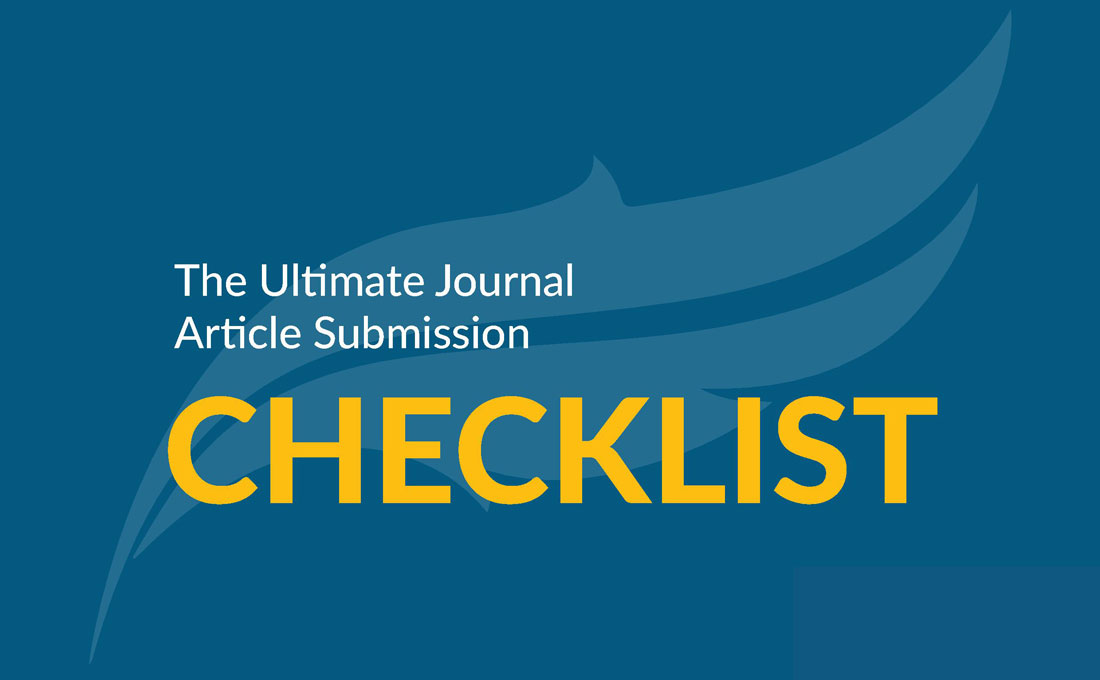
1. Selecting a Target Journal

Selecting a target journal is the crucial first step, but how do you select one?
Your topic may be specific enough that you have always had one journal in mind. If not, and if you are unsure about which journal to approach with your article, consider reviewing the sources that guided your research. If several of your sources were published in the same journal, that journal is likely a good fit for your article. If your sources have been published in a variety of leading journals (which is often the case), consider which journal is the most prestigious in your field (e.g., its impact factor). Also consider which aspect of your research you wish to highlight in your journal article.
Choose the most prestigious periodical that has published the most sources you will use for that specific aspect of your journal article submission. Furthermore, if you still need to choose from a group of potential target journals, have a quick look at the journals' respective limitations (e.g., word count, image count, referencing limits). This will let you determine the best available fit with the proposed scope of your article.
Finally, while scanning the limitations of prospective journals, consider your timeframe for publication. If you must publish your research quickly to stay ahead of the competition or for the sake of a performance review, pay attention to the general timeframe, from submission to publication, for any given journal. If Journal Alpha takes two months to receive, acknowledge, peer review, and publish an article, while Journal Beta takes six months to perform the same actions, perhaps a more time-sensitive article should be published with Journal Alpha , even if it is less prestigious than Journal Beta . Likewise, if Journal Alpha releases an accepted version of an article online prior to final publication and Journal Beta does not provide that preliminary service, perhaps a more time-sensitive article should be submitted to the former journal.
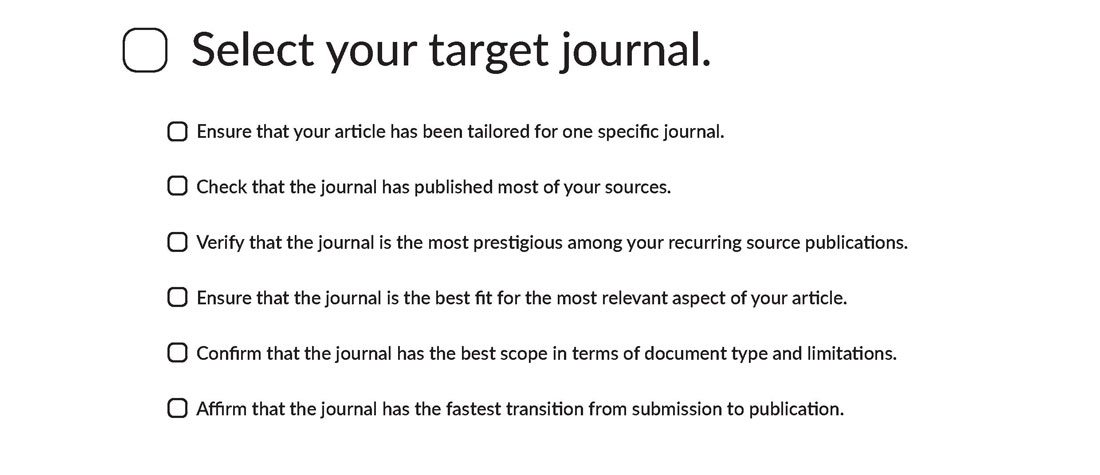
2. Checking Copyright Issues

The positioning of this step may seem totally wrong, but you should give copyright issues serious consideration as soon as possible!
First, consider how the research for this journal article aligns with the research from your previously published articles as the author or coauthor. Did you rely on ideas that you (or a coauthor) had developed in a previous paper? Is it enough to cite that previous document, or did you reuse specific portions of that text? If the latter, you will likely need to get permission from the copyright holder of the other publication. The good news is that academic publishers are often happy to let you reuse parts of your own ideas (with the appropriate citation to the original document and perhaps a note of gratitude in the acknowledgments).
Second, consider whether your journal article submission will include quotations from other texts and whether those quotations will fall within the realm of fair usage. Obviously, if you did not quote directly from other sources, this will not be an issue for you. However, for those of you who did quote extensively from other sources, check your target journal's guidelines to determine whether you need to get permission to quote certain texts. Copyright clearance can be quite time consuming and costly to procure, so check whether your target journal has staff dedicated to securing the rights to reproduce texts and whether your target journal has funds dedicated to cover the costs of copyrighted materials. If the answer is "no" to either or both conditions, start organizing these materials promptly. A copyright holder who denies your request may drastically change the content of your proposed journal article.
Third, consider whether you will include images and/or video files with your article. For those of you who will publish an article with nothing but words (and many journals, based on discipline and/or cost, do not require images or videos), this step can be skipped. But, for those of you who must include images (pictures, diagrams, graphs, etc.) and/or videos, there are several factors to keep in mind.
If your images and/or video files are not your own materials (e.g., archived photographs, previously established schematics, celebrated works of art), consider your target journal's procedures to secure the rights to reproduce those materials (as per the journal's procedures to reproduce copyrighted text, in the paragraph above). If your images and/or videos are your own materials (e.g., graphs generated through software associated with your research experiments or video recordings documenting your experimental setup), confirm that anyone appearing in the documents has given you written consent to use their likeness (or that you have sufficiently concealed their likeness). For your own materials, it is also best to check that the documents are consistent before you begin writing about them. If the axial label on one graph lists "Energy (kWh)" and another lists "Energy (kW h)," it would be best to redesign the graphs immediately, with one consistent expression for the unit of measurement (ideally, based on the target journal's preferences).
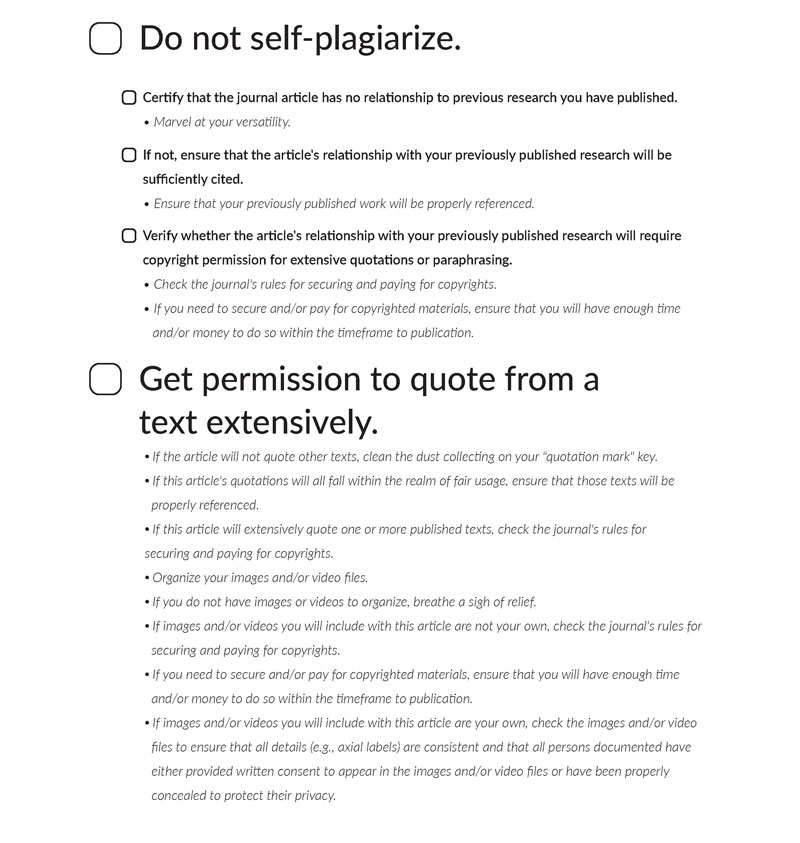
3. Establishing Formatting Parameters

You have selected your target journal and considered copyright issues; now, it's time to start writing . . . almost.
Before writing, you need to establish the formatting of the document(s) you will submit to the publisher. Some journals prefer one file format over another (e.g., a PDF rather than a Word document or multiple paper copies rather than a LaTeX file). Some journals provide templates (e.g., standardized Word documents or pre-encoded LaTeX files) to ensure consistency in formatting, but others simply list their rules for page size, font size, line spacing, heading style, etc. The key is to follow the publisher's rules precisely to make the best first impression. If the publisher provides a template, use it. If the publisher lists formatting rules, follow them. Period.
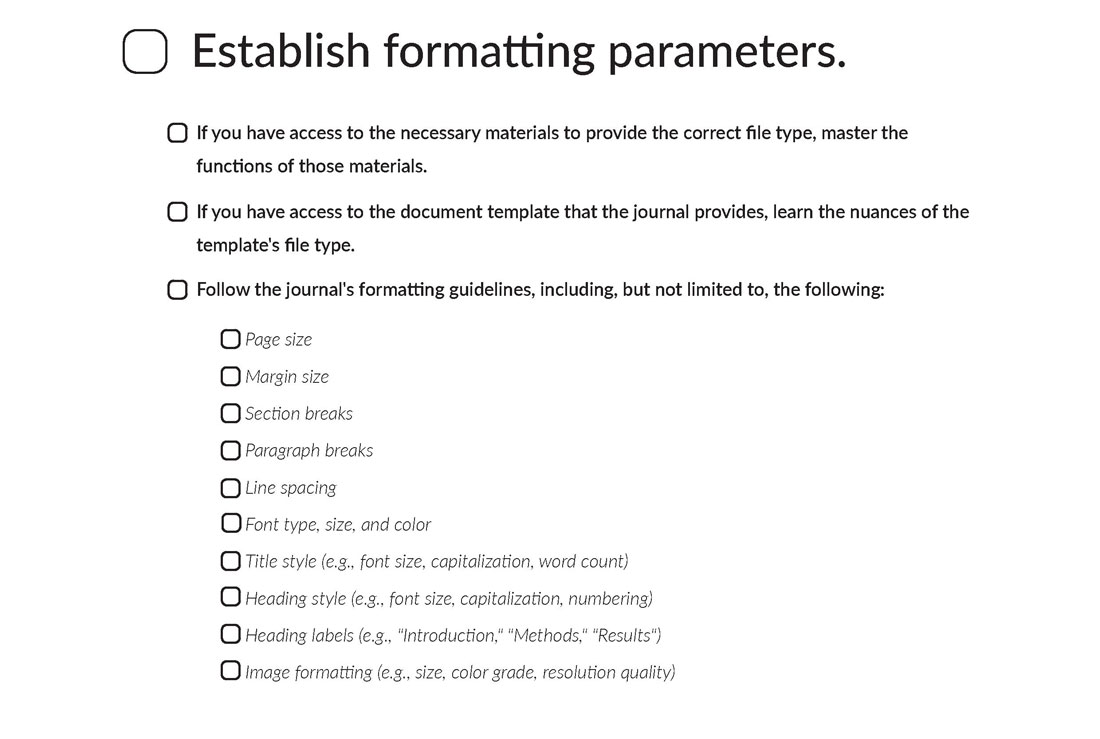
4. Writing the Article

There are plenty of articles to help you with this part of the process (e.g., " The Ultimate Essay Checklist ").
Without belaboring the point, it is enough to recommend that you write the main body of the text first, from introduction to conclusion. Second, develop a pithy title to catch the reader's attention; it should be informative and perhaps (depending on your audience) witty. Third, compose your abstract as a concise summary of the article's full scope, following the journal's requirements for abstract length, structure, and keyword creation. Fourth, provide all necessary authorial information, including your complete and accurate name(s), appropriate ranking of the authors in terms of contributions to the article (if you have written a coauthored journal article submission), proper affiliations for the author(s), current contact information for the corresponding author(s), and biographical information for the author(s), if needed. Fifth, acknowledge all support you received for this project, including (but not limited to) scholarships, grants, permissions, and non-authorial assistance (e.g., from students). Sixth, disclose any conflicts of interest. Seventh, create all necessary appendices, such as supplementary tables or additional diagrams. Eighth, organize your references, checking the relationship between the citations in the text itself (e.g., parenthetical citations or referential digits, depending on the journal) and the full bibliographical materials (e.g., thorough footnotes or a final reference list, depending on the journal). Finally, title, caption, and import the figures (for those of you using image and/or video files) either directly within the article or, more likely, as a separate document or folder of images and/or videos.
Once you have completed a full draft of your journal article and its supporting features, you should take a break (an hour, a day, a week, or even a month, depending on your timeframe) before returning to it for revisions. When in the midst of writing your first full draft, all writing may sound great, seem essential, and appear error free. However, after you have stepped away from the document for a while, your refreshed eyes will have a better chance of detecting awkward prose, tangential thoughts, and glaring errors. Eliminate these. You should also have a friend, colleague, or professional editing service read the draft and provide feedback to ensure that your text is clear, concise, and compliant with the guidelines of your target journal.
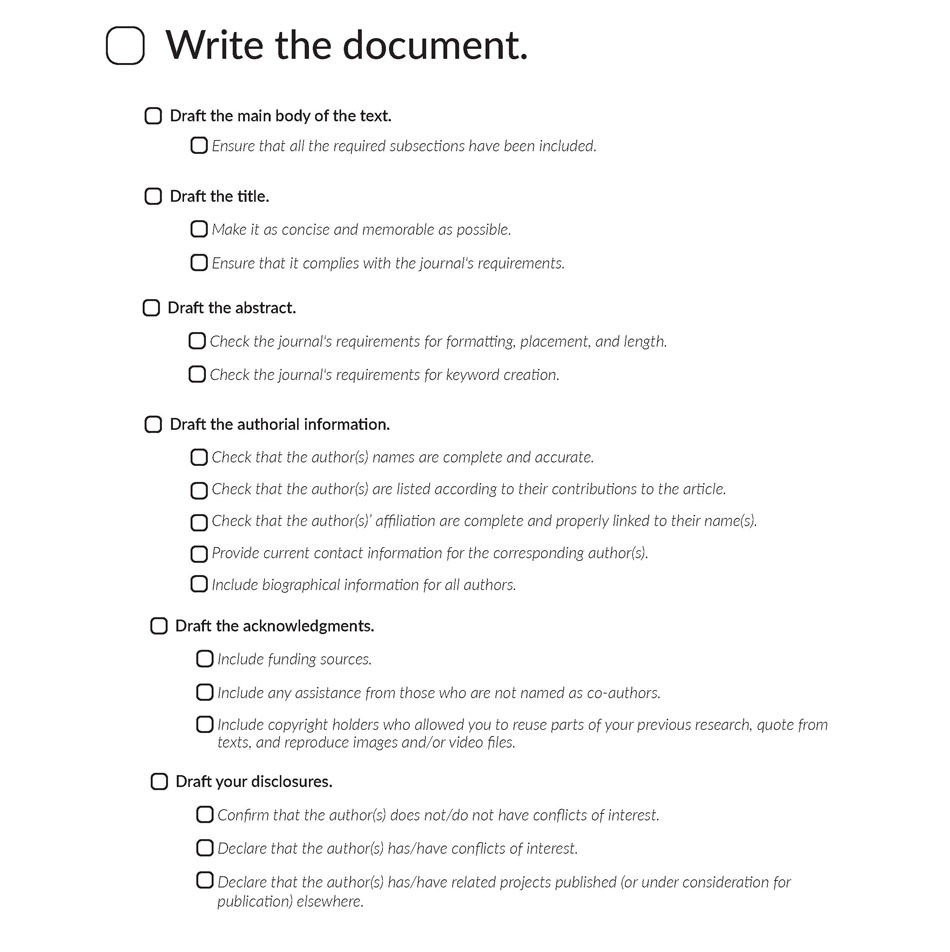
5. Submitting the Article

With all the details of the journal article finalized, you are now ready to submit the document(s).
First, confirm that the various parts of your article (e.g., the text and the images) are compliant with the journal's requirements. For example, if the journal requests that documents be labeled by lead author surname, short title, and then the word "Manuscript" or "Supplements," follow the phrasing exactly.
Second, start preparing all other information that may be necessary as part of the publication process. For example, if you are submitting to a peer-reviewed journal, the journal's editors may request that you provide a list of potential peer reviewers for them to contact. Have this list ready in case the journal editors request this information right away. As with your selection of a target journal, your list of peer reviewers should include authors from key sources cited in your article.
Third, write a cover letter to the journal's editors, enticing them to read your journal article submission. You have worked hard to complete the document(s) and are thrilled with your results. Make your future editors thrilled to discover your hard work, as well. Finally, send all the materials to the editors.
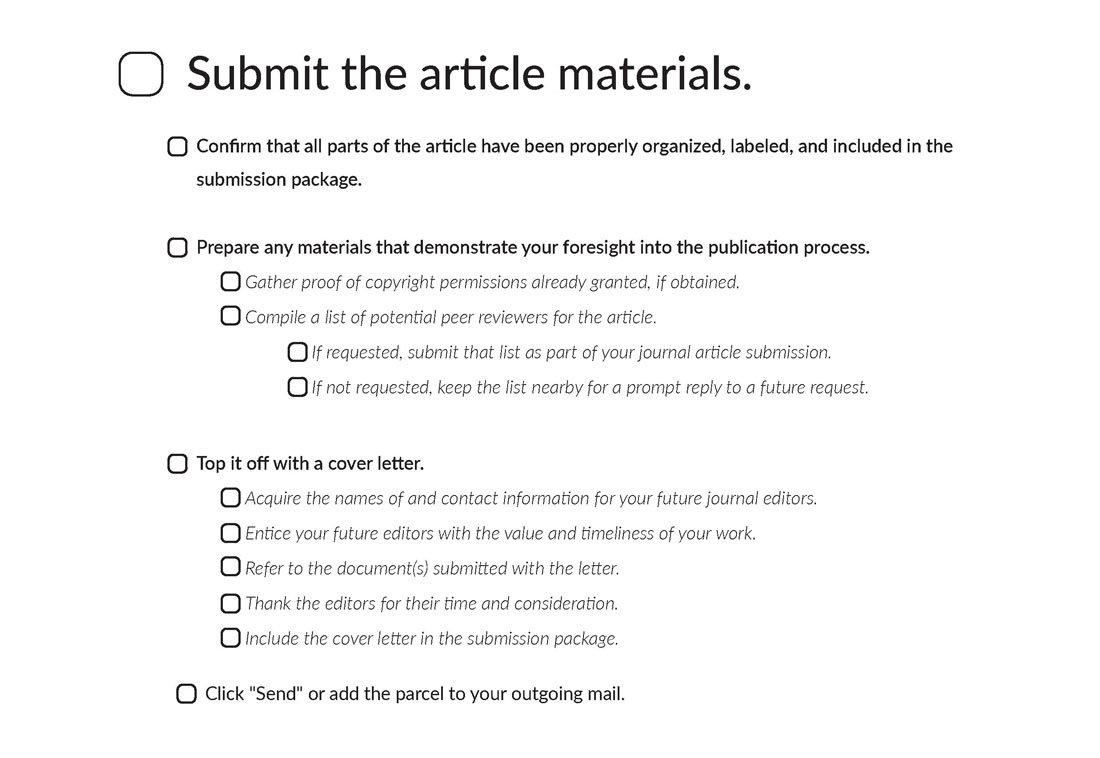
After following these steps, you will be more than ready to submit your journal article (at last!). Don't forget to download Scribendi's Ultimate Journal Article Submission Checklist for free to prepare your article and ensure that your journal article is submission ready. Happy writing!
Image source: stevanovicigor/elements.envato.com
Download Scribendi's Ultimate Journal Article Submission Checklist for free!
About the author.

Cameron is an in-house editor at Scribendi. He holds a PhD in the history and theory of architecture, specializing in the relationship between text and architecture. He is also a published scholar, having published one monograph, two book chapters, two exhibition catalogs, one interview, four journal articles, 17 conference papers, and counting! He also has nearly 20 years of teaching experience at universities throughout the world, putting his pedagogical skills to good use when crafting blog posts for Scribendi.
Have You Read?
"The Complete Beginner's Guide to Academic Writing"
Related Posts
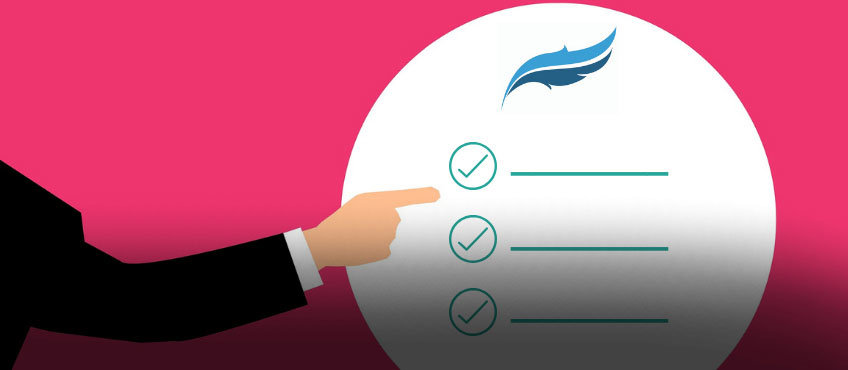
How to Edit and Proofread Your Writing to Engage Your Audience

The Ultimate Academic Writing Guide (Inspired by 35 Top Universities)

The Ultimate Essay Checklist
Upload your file(s) so we can calculate your word count, or enter your word count manually.
We will also recommend a service based on the file(s) you upload.
English is not my first language. I need English editing and proofreading so that I sound like a native speaker.
I need to have my journal article, dissertation, or term paper edited and proofread, or I need help with an admissions essay or proposal.
I have a novel, manuscript, play, or ebook. I need editing, copy editing, proofreading, a critique of my work, or a query package.
I need editing and proofreading for my white papers, reports, manuals, press releases, marketing materials, and other business documents.
I need to have my essay, project, assignment, or term paper edited and proofread.
I want to sound professional and to get hired. I have a resume, letter, email, or personal document that I need to have edited and proofread.
Prices include your personal % discount.
Prices include % sales tax ( ).


COMMENTS
Academic Writing Checklists | Free & Interactive. Published on September 18, 2017 by Koen Driessen. Revised on September 14, 2022. These interactive checklists help you improve your essay, research paper, thesis, or dissertation.
An academic essay is a focused piece of writing that aims to present a convincing argument using evidence, analysis and interpretation. It always has an introduction, a main body, and a conclusion. When you’ve finished writing your essay, use this checklist to evaluate your work.
Use this checklist as a guide for preventing academic integrity violations in your work.
10 things to do before you submit your essay. Final draft checklist. You have finished your essay and you think it is ready for submission. Now go through the checklist below, as it should help you spot possible flaws in your essay before submitting it.
This handout will help you unravel your assignment and begin to craft an effective response. Much of the following advice will involve translating typical assignment terms and practices into meaningful clues to the type of writing your instructor expects. See our short video for more tips.
Student Paper Checklist. Use this checklist while writing your paper to make sure it is consistent with seventh edition APA Style. This checklist corresponds to the writing and formatting guidelines described in full in the Publication Manual of the American Psychological Association (7th ed.).
This page contains four specific areas: Creating Effective Assignments. Checking the Assignment. Sequencing Writing Assignments. Selecting an Effective Writing Assignment Format. Creating Effective Assignments. Research has shown that the more detailed a writing assignment is, the better the student papers are in response to that assignment.
Paper submission checklist by John Bandler. Here is a checklist for students to use before submitting their paper or other written assignment. It can also be used by anyone submitting a written product, whether to a school, potential employer, client, etc.
This ultimate journal article submission checklist will help you organize, chronologize, and prioritize each aspect of article preparation for academic journal article submission.
This checklist summarises all the things you need to make sure you have in your essay or assignment before you submit it. It is quite long because there are a lot of things you need to check to make sure you get the proper reward for the effort you have put in.